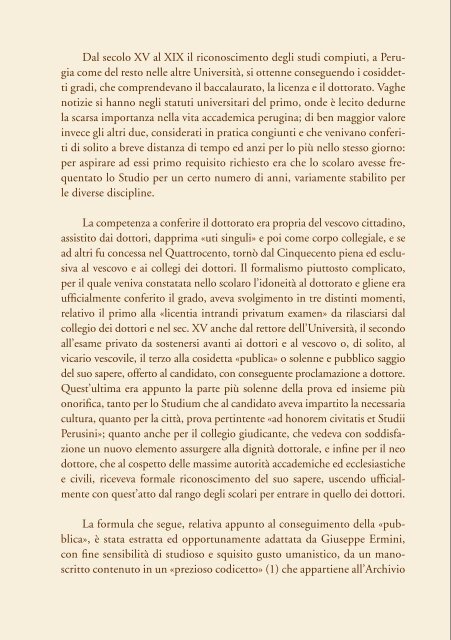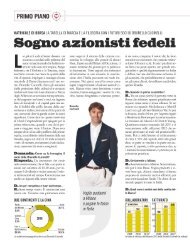LAUREA HONORIS CAUSA Brunello Cucinelli “La Dignità come ...
LAUREA HONORIS CAUSA Brunello Cucinelli “La Dignità come ...
LAUREA HONORIS CAUSA Brunello Cucinelli “La Dignità come ...
Create successful ePaper yourself
Turn your PDF publications into a flip-book with our unique Google optimized e-Paper software.
Dal secolo XV al XIX il riconoscimento degli studi compiuti, a Perugia<br />
<strong>come</strong> del resto nelle altre Università, si ottenne conseguendo i cosiddetti<br />
gradi, che comprendevano il baccalaurato, la licenza e il dottorato. Vaghe<br />
notizie si hanno negli statuti universitari del primo, onde è lecito dedurne<br />
la scarsa importanza nella vita accademica perugina; di ben maggior valore<br />
invece gli altri due, considerati in pratica congiunti e che venivano conferiti<br />
di solito a breve distanza di tempo ed anzi per lo più nello stesso giorno:<br />
per aspirare ad essi primo requisito richiesto era che lo scolaro avesse frequentato<br />
lo Studio per un certo numero di anni, variamente stabilito per<br />
le diverse discipline.<br />
La competenza a conferire il dottorato era propria del vescovo cittadino,<br />
assistito dai dottori, dapprima «uti singuli» e poi <strong>come</strong> corpo collegiale, e se<br />
ad altri fu concessa nel Quattrocento, tornò dal Cinquecento piena ed esclusiva<br />
al vescovo e ai collegi dei dottori. Il formalismo piuttosto complicato,<br />
per il quale veniva constatata nello scolaro l’idoneità al dottorato e gliene era<br />
ufficialmente conferito il grado, aveva svolgimento in tre distinti momenti,<br />
relativo il primo alla «licentia intrandi privatum examen» da rilasciarsi dal<br />
collegio dei dottori e nel sec. XV anche dal rettore dell’Università, il secondo<br />
all’esame privato da sostenersi avanti ai dottori e al vescovo o, di solito, al<br />
vicario vescovile, il terzo alla cosidetta «publica» o solenne e pubblico saggio<br />
del suo sapere, offerto al candidato, con conseguente proclamazione a dottore.<br />
Quest’ultima era appunto la parte più solenne della prova ed insieme più<br />
onorifica, tanto per lo Studium che al candidato aveva impartito la necessaria<br />
cultura, quanto per la città, prova pertintente «ad honorem civitatis et Studii<br />
Perusini»; quanto anche per il collegio giudicante, che vedeva con soddisfazione<br />
un nuovo elemento assurgere alla dignità dottorale, e infine per il neo<br />
dottore, che al cospetto delle massime autorità accademiche ed ecclesiastiche<br />
e civili, riceveva formale riconoscimento del suo sapere, uscendo ufficialmente<br />
con quest’atto dal rango degli scolari per entrare in quello dei dottori.<br />
La formula che segue, relativa appunto al conseguimento della «pubblica»,<br />
è stata estratta ed opportunamente adattata da Giuseppe Ermini,<br />
con fine sensibilità di studioso e squisito gusto umanistico, da un manoscritto<br />
contenuto in un «prezioso codicetto» (1) che appartiene all’Archivio<br />
From the 15 th through 19 th centuries at Perugia as well as at the<br />
other Universities, the recognition of completed studies was achieved by<br />
obtaining so-called degrees, which were comprised of the baccalaureate, the<br />
licence and the doctorate. There are vague notions among the University<br />
statutes regarding the first, by which we may deduce its relatively minute<br />
importance in Perugian academic life. However, the other two are of far<br />
greater value, practically considered as inseparable, and normally granted<br />
in close temporal proximity to each other, even on the same day. To aspire to<br />
these degrees, the scholar was first required to have attended the Studium for<br />
a certain number of years, as established according to the various disciplines.<br />
Only the city’s Bishop, assisted by other doctors, first as “uti singuli” and later<br />
as the collegial body, had the authority to confer the doctorate. Although others<br />
were granted this authority in the 15 th century, the Bishop once again regained<br />
this exclusive authority, along with the college of doctors, in the 16 th century. The<br />
rather complicated formalism with which the scholar was deemed eligible for<br />
the doctorate and by which he ultimately achieved his degree was articulated in<br />
three distinct moments. The first was relative to the “licentia intrandi privatum<br />
examen” issued by the College of Doctors and during the fifteenth century by the<br />
University’s Rector, the second was a private examination held before the doctors<br />
and the Bishop, or more often his deputy, and the third called the “pubblico”,<br />
was a solemn and public example of the candidate’s knowledge, followed by a<br />
proclamation of doctorship. The latter was, in fact, the most solemn part of the trial<br />
and also the most honourable, as much for the Studium, which had imparted the<br />
candidate with the necessary culture, as it was for the city, the pertinent attestation<br />
“ad honorem civitatis et Studii Perusini”; but also for the college of judges, who<br />
had the satisfaction of seeing a new element rise up to doctoral dignity, and finally<br />
for the neo-doctor, who in the presence of the highest academic, ecclesiastic and<br />
civil authorities, received formal recognition of his knowledge, and with this act<br />
officially moved beyond the ranks of scholar to join those of the doctors.<br />
The following formula, which relates precisely to the conferral of the “pubblico”,<br />
has been extracted and appropriately adapted by Giuseppe Ermini, with the fine<br />
sensibility of a scholar of exquisite humanistic taste, from a manuscript contained<br />
within a “precious little codex” (1) that belongs to the University Archives of<br />
28 29




